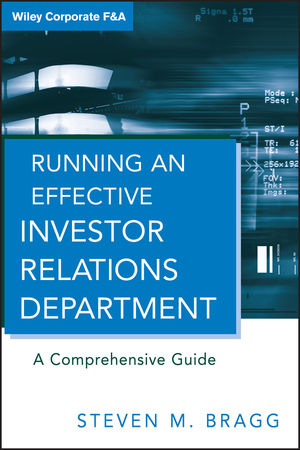Running an Effective Investor Relations Department: A Comprehensive GuideISBN: 978-0-470-63030-3
Hardcover
272 pages
August 2010
 This is a Print-on-Demand title. It will be printed specifically to fill your order. Please allow an additional 15-20 days delivery time. The book is not returnable.
|
||||||
Preface xi
About the Author xiii
Chapter 1: Managing Investor Relations 1
Why Have an Investor Relations Department? 1
Investor Relations Objectives and Goals 2
Investor Relations Tools 3
Investor Relations Budget 6
Float Management 8
Managing Bad News 10
Responding to Rumors 14
Summary 15
Chapter 2: Investor Relations Officer Position 16
Key Aspects of the IRO Position 16
IRO Job Description 19
Investor Relations Team 21
IRO as Management Representative 22
Summary 23
Chapter 3: Creating the Company Story 24
Creating the Story 24
Packaging the Story 26
Strategic Credibility 29
Clarifying and Mitigating Risk 30
Company Reputation 32
Matching the Company to the Story 34
Duration of the Story 34
Coordination with Public Relations 35
Summary 35
Chapter 4: Event Management 37
Conference Call 37
Road Show 41
Non-Deal Road Show 46
Annual Meeting 47
Plant Tour 49
Annual Analyst Meeting 49
Analyst and Industry Conferences 50
Podcast Dissemination 50
Video Dissemination 52
Blog Dissemination 52
Event Disclosure Issues 53
Practicing for Events 54
Summary 55
Chapter 5: Public Communications 57
Constructing a Press Release 57
Dealing with the Media 63
Dealing with Electronic Message Boards 66
Investor Relations Advertising 67
Summary 68
Chapter 6: Publications 69
Fact Sheet 69
Annual Report 74
Product Pipeline Report 77
Company-Paid Research Reports 78
Independent Research Reports 78
Welcome Kit 79
Videos 79
Other Publications 80
Information Tracking Systems for Publications 81
Legal Liability 82
Summary 82
Chapter 7: Investor Relations Web Site 83
Basic Investor Relations Web Site 83
Intermediate Investor Relations Web Site 84
Advanced Investor Relations Web Site 87
Web Site Layout 90
Hyperlink Liability 91
Sample Web Sites 92
Summary 93
Chapter 8: Management Discussion and Analysis Section 94
MD&A Reporting Requirements 94
SEC Guidance 98
Examples of Enhanced MD&A Disclosure 99
A Case for Full Disclosure 101
Summary 102
Chapter 9: Disclosure 103
Form 8-K 104
Disclosure of Non-GAAP Information 111
Regulation FD 114
Disclosure Policy 115
Disclosure Procedure 117
Ensuring Compliance with Disclosure Rules 118
Disclosure During an Initial Public Offering 120
Summary 121
Chapter 10: Forward-Looking Statements 122
Basis for Class Action Lawsuits 122
Private Securities Litigation Reform Act 123
Forward-Looking Statements 124
Legal Liability for Past Statements 127
Summary 127
Chapter 11: Providing Guidance 128
Whether to Provide Guidance 128
Form of Guidance Issued 130
Frequency and Timing of Guidance 132
Aggressiveness of Guidance 133
Guidance Policy 134
Summary 135
Chapter 12: Dealing with the Sell Side 136
Analyst’s Perspective 136
Finding the Right Analyst 139
Dealing with Analysts 140
Negative Analyst Report 144
Dealing with Brokers 145
Pump and Dump 147
Dealing with Investment Bankers 148
Dealing with Sell-Side Specialists 149
Summary 149
Chapter 13: Dealing with the Buy Side 151
Types of Investors 151
Dealing with Institutional Investors 153
Travel Requirements for Meetings with Institutional Investors 156
Dealing with Individual Investors 158
Dealing with Investment Clubs 160
Dealing with Foreign Investors 161
Investor Presentation 162
Managing a Private Investment in Public Equity 164
Accredited Investor 164
Dividend Reinvestment 165
Direct Stock Purchase Plans 165
Summary 166
Chapter 14: Dealing with Credit Rating Agencies 167
Credit Rating Agency Relationship 167
Summary 169
Chapter 15: Dealing with Short Sellers and Activist Investors 170
How Short Sellers Operate 170
How to Handle Short Sellers 172
Monitoring Short Sellers 174
Dealing with Activist Investors 174
Summary 175
Chapter 16: Dealing with the Board of Directors 177
IRO and the Board of Directors 177
Investor Relations Board Packet 182
Summary 182
Chapter 17: Major Stock Exchanges 183
Listing Process 183
American Stock Exchange 184
Overview of the NASDAQ 187
NASDAQ Capital Market 187
NASDAQ Global Market 188
New York Stock Exchange 190
Comparing the Stock Exchanges 191
Summary 193
Chapter 18: Monitoring the Market 194
Monitoring through Internet Services 194
Monitoring through Individuals 195
Surveying Investors 196
Locating Investors 199
Monitoring through a Stock Surveillance Service 200
Monitoring through a Stock Transfer Agent 201
Bloomberg Terminals 201
Electronic Message Boards 201
Activity Caused by Trading Strategies 202
Summary 204
Chapter 19: Blue Sky Laws 206
Blue Sky Law Requirements and Implications 206
Blue Sky Advice for the IRO 208
Chapter 20: Proxy Solicitations 209
Proxy Solicitation Concepts 209
Online Proxy Voting 215
Proxy Distribution Process 218
NYSE Rule 452 222
Summary 223
Chapter 21: Dividends and Stock Buy-Backs 224
Transition to a Dividend 224
Dividend Policy 225
Stock Buy-Back Alternative 227
SEC Conditions on Stock Buy-Backs 228
Disclosure of a Stock Buy-Back Program 229
Odd-Lot Shareholdings 231
Summary 232
Chapter 22: Outsourcing Investor Relations 233
Skill Set of an Investor Relations Consultant 233
Managing the Consultant Relationship 236
National Investor Relations Institute 237
Summary 237
Chapter 23: Investor Relations Metrics 239
Internal and Financial Metrics 239
Peer Metrics 244
Company-Specific Metrics 245
Metrics Consistency 246
Explaining Results 247
Summary 249
Index 250



